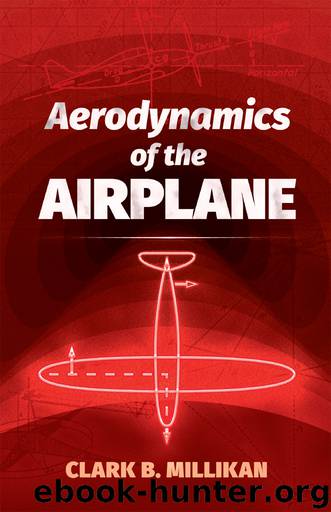Aerodynamics of the Airplane by Clark B. Millikan

Author:Clark B. Millikan
Language: eng
Format: epub
Publisher: Dover Publications, Inc.
Published: 2018-05-22T04:00:00+00:00
FIG. 2·28. Trailing vortices and lift distribution for a wing with longitudinal slot.
An especially deleterious modification or mutilation of a wing is anything which causes the lift to fall to zero at some point between the two wing tips. Even a very small fore-and-aft, or longitudinal, slot makes the lift fall to zero and introduces two new trailing vortices (cf. Fig. 2·28). Not only is the lift greatly reduced, but the induced drag is enormously increased. In one case which occurred some years ago in a small training plane, sealing such a slot, which was perhaps one-half inch wide, doubled the rate of climb. An unfortunate junction between the wing and fuselage of a low-wing airplane, even though no gap in the wing exists, may have similar deleterious effects. If the junction is good the wing lift will carry across the fuselage and the lift distribution will be essentially the same whether or not the fuselage is mounted on the wing. If, however, the junction is bad premature separation will occur at the wing-fuselage intersections at very low angles of attack. The lift may then drop nearly to zero over the wing portion covered by the fuselage, additional trailing vortices appear which give a large drag increase, and a situation much like that of Fig. 2·28 occurs. It is often possible to transform an unsatisfactory wing-fuselage intersection into a completely satisfactory one by means of properly designed fillets.
Download
This site does not store any files on its server. We only index and link to content provided by other sites. Please contact the content providers to delete copyright contents if any and email us, we'll remove relevant links or contents immediately.
Tools of Titans by Timothy Ferriss(7811)
Turbulence by E. J. Noyes(7700)
Astrophysics for People in a Hurry by Neil DeGrasse Tyson(5000)
Secrets of Antigravity Propulsion: Tesla, UFOs, and Classified Aerospace Technology by Ph.D. Paul A. Laviolette(4990)
Design of Trajectory Optimization Approach for Space Maneuver Vehicle Skip Entry Problems by Runqi Chai & Al Savvaris & Antonios Tsourdos & Senchun Chai(4839)
Room 212 by Kate Stewart(4732)
Pale Blue Dot by Carl Sagan(4613)
The David Icke Guide to the Global Conspiracy (and how to end it) by David Icke(4377)
A Journey Through Divination and Astronomy by Publishing Pottermore(4248)
Apollo 8 by Jeffrey Kluger(3512)
Goodbye Paradise(3444)
Losing the Nobel Prize by Brian Keating(3425)
COSMOS by Carl Sagan(3346)
The Five People You Meet in Heaven by Mitch Albom(3334)
How to Read Water: Clues and Patterns from Puddles to the Sea (Natural Navigation) by Tristan Gooley(3239)
Brief Answers to the Big Questions by Stephen Hawking(3239)
How to Read Nature by Tristan Gooley(3077)
The Order of Time by Carlo Rovelli(3073)
A Brief History of Time by Stephen Hawking(2819)
